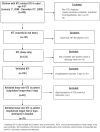Risk factors for in-hospital venous thromboembolism in children: a case-control study employing diagnostic validation
- PMID: 22133768
- PMCID: PMC3347665
- DOI: 10.3324/haematol.2011.054775
Risk factors for in-hospital venous thromboembolism in children: a case-control study employing diagnostic validation
Abstract
Background: Studies evaluating risk factors for in-hospital venous thromboembolism in children are limited by quality assurance of case definition and/or lack of controlled comparison. The objective of this study is to determine risk factors for the development of in-hospital venous thromboembolism in children.
Design and methods: In a case-control study at The Children's Hospital, Colorado, from 1(st) January 2003 to 31(st) December 2009 we employed diagnostic validation methods to determine pediatric in-hospital venous thromboembolism risk factors. Clinical data on putative risk factors were retrospectively collected from medical records of children with International Classification of Diseases, 9th edition codes of venous thromboembolism at discharge, in whom radiological reports confirmed venous thromboembolism and no signs/symptoms of venous thromboembolism were noted on admission.
Results: We verified 78 cases of in-hospital venous thromboembolism, yielding an average incidence of 5 per 10,000 hospitalized children per year. Logistical regression analyses revealed that mechanical ventilation, systemic infection, and hospitalization duration of five days or over were statistically significant, independent risk factors for in-hospital venous thromboembolism (OR=3.29, 95%CI=1.53-7.06, P=0.002; OR=3.05, 95%CI=1.57-5.94, P=0.001; and OR=1.03, 95%CI=1.01-1.04, P=0.001, respectively). Using these factors in a risk model, post-test probability of venous thromboembolism was 3.6%.
Conclusions: These data indicate that risk of in-hospital venous thromboembolism in children with this risk factor combination may exceed that of hospitalized adults in whom prophylactic anticoagulation is indicated. Substantiation of these findings via multicenter studies could provide the basis for future risk-stratified randomized control trials of pediatric venous thromboembolism prevention.
Figures
References
-
- [Accessed 22 December 2010]. http://www.surgeongeneral.gov/topics/deepvein/calltoaction/call-to-actio....
-
- Manco-Johnson MJ, Goldenberg NA. Thrombosis in the pediatric patient: unique risk factors, diagnosis, and management issues. The Surgeon General’s Workshop on Deep Venous Thrombosis; Bethesda, MD. 2006. pp. 8–9.
-
- Stein PD, Kayali F, Olson RE. Incidence of venous thromboembolism in infants and children: data from the National Hospital Discharge Survey. J Pediatr. 2004;145(4):563–5. - PubMed
-
- Raffini L, Huang Y-S, Witmer C, Feudtner C. Dramatic increase in venous thromboembolism in children’s hospitals in the United States from 2001 to 2007. Pediatrics. 2009;124(4):1001–8. - PubMed
-
- Journeycake J, Manco-Johnson MJ. Thrombosis during infancy: what we know and what we do not know. Hematol Oncol Clin North Am. 2004;18(6):1315–38. - PubMed
Publication types
MeSH terms
Grants and funding
LinkOut - more resources
Full Text Sources


